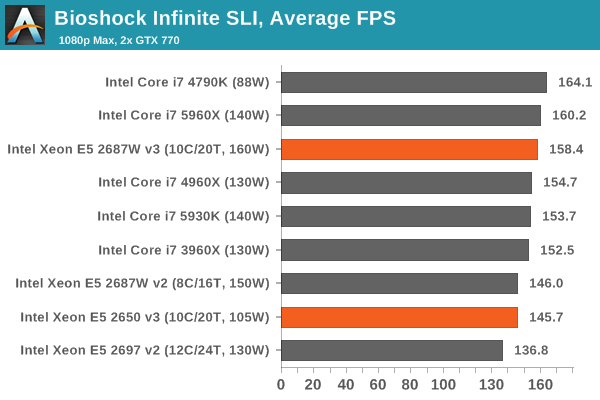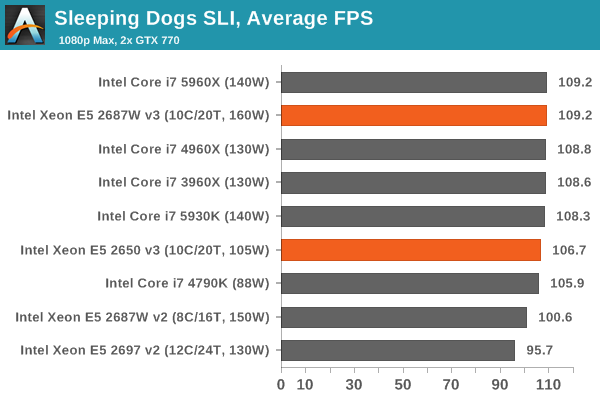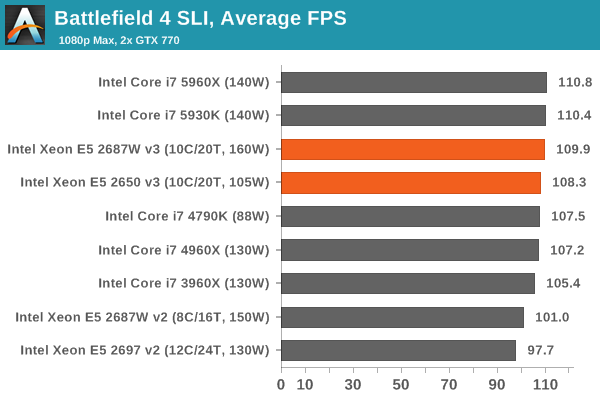Intel Xeon E5-2687W v3 and E5-2650 v3 Review: Haswell-EP with 10 Cores
by Ian Cutress on October 13, 2014 10:00 AM EST- Posted in
- CPUs
- IT Computing
- Intel
- Xeon
- Enterprise
- Enterprise CPUs
Gaming Benchmarks
F1 2013
First up is F1 2013 by Codemasters. I am a big Formula 1 fan in my spare time, and nothing makes me happier than carving up the field in a Caterham, waving to the Red Bulls as I drive by (because I play on easy and take shortcuts). F1 2013 uses the EGO Engine, and like other Codemasters games ends up being very playable on old hardware quite easily. In order to beef up the benchmark a bit, we devised the following scenario for the benchmark mode: one lap of Spa-Francorchamps in the heavy wet, the benchmark follows Jenson Button in the McLaren who starts on the grid in 22nd place, with the field made up of 11 Williams cars, 5 Marussia and 5 Caterham in that order. This puts emphasis on the CPU to handle the AI in the wet, and allows for a good amount of overtaking during the automated benchmark. We test at 1920x1080 on Ultra graphical settings.

Bioshock Infinite
Bioshock Infinite was Zero Punctuation’s Game of the Year for 2013, uses the Unreal Engine 3, and is designed to scale with both cores and graphical prowess. We test the benchmark using the Adrenaline benchmark tool and the Xtreme (1920x1080, Maximum) performance setting, noting down the average frame rates and the minimum frame rates.

Tomb Raider
The next benchmark in our test is Tomb Raider. Tomb Raider is an AMD optimized game, lauded for its use of TressFX creating dynamic hair to increase the immersion in game. Tomb Raider uses a modified version of the Crystal Engine, and enjoys raw horsepower. We test the benchmark using the Adrenaline benchmark tool and the Xtreme (1920x1080, Maximum) performance setting, noting down the average frame rates and the minimum frame rates.

Sleeping Dogs
Sleeping Dogs is a benchmarking wet dream – a highly complex benchmark that can bring the toughest setup and high resolutions down into single figures. Having an extreme SSAO setting can do that, but at the right settings Sleeping Dogs is highly playable and enjoyable. We run the basic benchmark program laid out in the Adrenaline benchmark tool, and the Xtreme (1920x1080, Maximum) performance setting, noting down the average frame rates and the minimum frame rates.

Battlefield 4
The EA/DICE series that has taken countless hours of my life away is back for another iteration, using the Frostbite 3 engine. AMD is also piling its resources into BF4 with the new Mantle API for developers, designed to cut the time required for the CPU to dispatch commands to the graphical sub-system. For our test we use the in-game benchmarking tools and record the frame time for the first ~70 seconds of the Tashgar single player mission, which is an on-rails generation of and rendering of objects and textures. We test at 1920x1080 at Ultra settings.
















27 Comments
View All Comments
JarredWalton - Monday, October 13, 2014 - link
For ten cores I wouldn't expect a huge bump over the "minimum guaranteed" speed. It's one thing to boost a few cores by a large amount, but the whole problem with multi-core designs is that if you load up all the cores then either you have massive power consumption or you need to curtail the clocks. Honestly, running ten cores at 100% and still hitting 3.1GHz is impressive in my book -- and it still consumes up to 160W.Carl Bicknell - Monday, October 13, 2014 - link
I got my numbers a bit wrong: the 2687W is 3.1 GHz default and 3.2 GHz all cores on turbo, according to wikipedia.That's disappointing.
Apart from anything else, they've managed to get their best 12 (yes twelve!) core CPU (E5-2690 v3) to operate at 3.1 GHz turbo all cores in a 135 W design.
With two fewer cores and an extra 25 watts I'd hope for more than a mere 100 MHz performance.
NovoRei - Monday, October 13, 2014 - link
Ian, could you comment on performance with pure AVX2 and mixed AVX instructions and where the W version stands?Thanks.
Laststop311 - Monday, October 13, 2014 - link
4100 for an 18 core ill take 2ruthan - Tuesday, October 14, 2014 - link
I would like to see, benchmarks some of those low power - 6/12 or 12/24 - 55W a 65W models.pokazene_maslo - Tuesday, October 14, 2014 - link
Is it possible to override turbo boost to force all cores to run at maximum turbo freqency? (E5-2687W-v3 running all cores at 3.5GHz)alpha754293 - Tuesday, October 14, 2014 - link
Well, the thing with these "big" multicore systems is no different than testing large SMP system. You have to use programs for applications that where it make sense to use it. For engineering analyses and simulations, even HOW a problem is divided up (from a single, much larger problem) can have an impact on not only the speed for the analysis/simulation, but also the accuracy of the simulation, and you have to have a pretty sound understanding of the math and physics involved in order to make the best determination.And for some applications, there is such a thing and you CAN have TOO many cores (where you've divided up a problem so much that it's now so small that it can't fully load a core up anymore, and that the process of dividing and re-assembling the results takes an extremely large amount of time.) (You can run into that with some of the FEA analysis).
I was working with Johan and studying a while slew of parameters using LS-DYNA to study how the various ways of decomposing a problem can have an impact on the crash test simulation results, and how swap performance means EVERYTHING when it comes to mechanical engineering simluations.
mapesdhs - Thursday, October 16, 2014 - link
Oddly enough this can be the case with animation rendering aswell. I know a movie studio
which uses a system that can exclude cores from a render pipeline so there is more RAM
and cache bandwidth available with a fewer number of cores. This can matter because
sometimes complex film renders can use huge amounts of data. Someone at SPI told me
one frame of a big movie can involve 500GB of data.
Interesting how the same issue can crop up in such widely different fields.
Ian.
RAMdiskSeeker - Tuesday, October 14, 2014 - link
Could you please test these motherboards for supporting ECC unbuffered DIMMs, reporting that ECC is active, and overclocking potential with ECC DIMMs? It would be good to know whether Xeon chips on non-server motherboards can use ECC.nutral - Tuesday, October 14, 2014 - link
What still is strange to me is that there is still no workstation cpu focused on a workstation with single threaded software. Wouldn't an i7 cpu still be much faster than this workstation cpu?